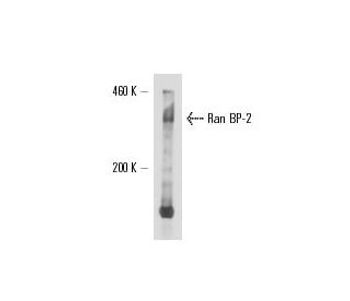
Ran BP-2 (D-4) Alexa Fluor® 647 | Santa Cruz Biotechnology
mouse monoclonal IgG1; Ran BP-2 Antibody (D-4) is an IgG1 κ mouse monoclonal Ran BP-2 antibody (also designated RANBP2 antibody, RBP2 antibody, RAN Binding Protein 2 antibody, NUP358 antibody, Nuclear Pore Complex Protein Nup358 antibody, E3 SUMO-Protein Ligase RanBP2 antibody, Ran-Binding Protein 2 antibody, 358 KDa Nucleoporin antibody, Nucleoporin Nup358 antibody, Nucleoporin 358 antibody, ADANE antibody, P270 antibody, E3 SUMO-Protein Transferase RanBP2 or Transformation-Related Protein 2 antibody) that detects the Ran BP-2 protein of mouse, rat and human origin by WB, IP, IF and ELISA. Ran BP-2 Antibody (D-4) is available as both the non-conjugated anti-Ran BP-2 antibody form, as well as multiple conjugated forms of anti-Ran BP-2 antibody, including agarose, HRP, PE, FITC and multiple Alexa Fluor® conjugates. The small Ras-related protein Ran, also known as TC4, is a nuclear-localized GTPase implicated in a diverse array of cellular processes including DNA replication, entry into and exit from mitosis, and the transport of RNA and proteins through the nuclear pore complex. Ran-binding protein 2 (Ran BP-2 or Nup358) is a large scaffold cyclophilin-related protein expressed in photoreceptor cells that contains four RanBD1 domains. Localization at cytoplasmic fibrils emanates Ran BP-2 from the nuclear pore complex, which then interacts with Ran-GTPase to support its role in nucleocytoplasmic transport processes. In humans, the Ran BP-2 gene lies in a hot spot for recombination on chromosome 2q. The genetic heterogeneity renders further significance of this genomic region in human disease due to its possible involvement in genetically linked disorders such as juvenile nephronophthisis, congenital hepatic fibrosis and chorioretinal dysplasia. Duplication events that occurred at the 3 Mb distal to Ran BP-2 gave rise to eight new genes encoding RGPD (RanBP2-like), GRIP domain-containing proteins, which are highly homologous to Ran BP-2.

























































